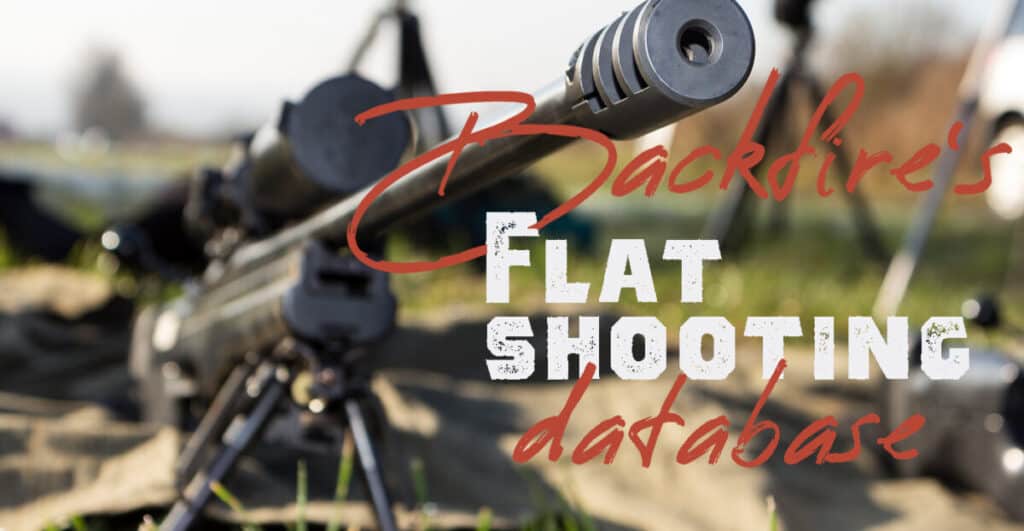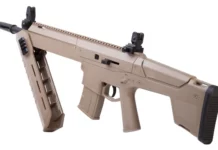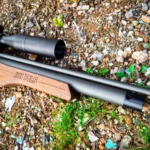
Right now, shooters are obsessed with flat-shooting rifle cartridges. The advent of precision rifle competitions and the laser rangefinder has increased the public’s desire to go long. But what are the flattest shooting rifle cartridges?
The flattest-shooting popular rifle cartridge at 1,000 yards is the 6.5-300 Weatherby Magnum, followed by the .26 Nosler, the .28 Nosler, the .22 Creedmoor, and the 6.5 Weatherby RPM. These cartridges all drop less than 255″ at 1,000 yards.
The following table averages multiple loads for each cartridge and shows an average amount of drop at 500 yards and 1,000 yards for each cartridge.
The flattest-shooting cartridges usually have Nosler or Weatherby in their name, and the top three flat-shooting cartridges were created by those respected companies. As much talk as there is about the .270 Winchester’s ability to shoot flatly, it does not compare with these three flat-shooting options.
6.5mm and 7mm projectiles offer very high ballistic coefficients, meaning they offer excellent ability to overcome drag and wind deflection over longer distances. When considering cartridges for their ability to shoot flat, overcoming drag is critical.
When a bullet is fired, many forces are immediately working against it: gravity, wind, and atmospheric drag.
As soon as a projectile leaves the muzzle, the earth’s gravity instantly begins to affect the trajectory of the round. Equally, cutting through the air slows the projectile down, eating away at its energy. Wind also affects bullets differently, and a cartridge’s ability to overcome these three forces makes it better or worse for shooting flat and far.
Spinning high B.C. bullets at faster speeds allows the projectile to get to the target sooner, minimizing the amount of time all three forces have to affect the bullet’s trajectory.
The way in which cartridge manufacturers develop rounds to overcome these forces is the twist rates of the barrels in the rifles the cartridges are chambered in, developing longer, more aerodynamic bullets with narrower ogives and case capacity.
Barrel twist rates spin the bullet out of the muzzle in a spiral much akin to a quarterback throwing a football. The spin rate helps to stabilize the projectile along its path, cut through drag and higher case capacities give the projectile more velocity thus delivering the bullet to the target more quickly.
The 26 and 28 Nosler as well as the 6.5×300 Weatherby Magnum all utilize heavy for caliber bullets with high ballistic coefficients that are stabilized by barrels with fast twist rates. All three cartridges also offer ample case capacity, allowing enough powder to send bullets at drag-defying velocities.
Below is a chart indicating the three best flat-shooting cartridges and their muzzle velocity, drop, energy levels, and felt recoil. Recoil statistics are offered for reference.
You can compare these numbers with your favorite cartridge using Backfire’s own table of flat shooting cartridges and you will see that the numbers indicated are in the absolute upper tiers. But let’s take a quick look at a historically popular “flat-shooting” cartridge, the .270 Winchester.
As you can see, one of our gold standard flat-shooting cartridges (.270 Winchester) does not compare favorably with either of the Noslers or the Weatherby Magnum. Of course, the .270 Win was developed in 1925 when 1000 yard shots were effectively unheard of.
This is not just a product of the .27 caliber bullet and its ballistic coefficient numbers. Case capacity is literally and figuratively the driving force here:
Both Nosler offerings are based on the 300 Remington Ultra Magnum and both boast case capacities of 93.5 grains of water. The 6.5×300 Weatherby magnum, as its name suggests, is based on the 300 Weatherby mag and has a case capacity of 98 grains of water. By way of comparison, the .270 Winchester (based on the .30-06 Springfield) offers a case capacity of 67 grains.
Deciding on the three best flat-shooting cartridges does not come down simply to one statistic, but a combination of all the factors inherent to a cartridge. Velocity, drop, energy and the use of bullets with their own factors which create their ballistic coefficients all should be considered.
Any cartridge that drops less than 40 inches at 500 yards or close to 200 inches at 1000 yards should be considered a flat shooting cartridge. The amount of drop is directly influenced by velocity, energy, rifle barrel, and bullet design.
With those thoughts in mind, it is easy to see why the 26 Nosler, 28 Nosler and the 6.5×300 Weatherby Magnums are the best flat-shooting cartridges offered to rifle shooters today.
Does Flat Shooting Even Matter?
Since nearly all long-distance shooters today use a laser rangefinder, does it even matter which cartridges shoot the flattest? Does it matter if there are -30″ of drop or -40″ of drop if the answer is simply to spin the turret a few extra clicks?
One argument for a flat-shooting cartridge is that it covers mistakes. I was once hunting plains game in Africa when my PH told me, holding a rangefinder, that the wildebeest was 155 yards away. I took the shot prone and then stood up after the wildebeest tipped over after a perfect shot.
I was surprised at the distance, so I asked my PH “That’s just 155 yards?” He got a stunned look on his face and said, “No, TWO hundred fifty-five yards!” Our miscommunication during the shot sequence didn’t matter a bit, because I was shooting a .28 Nosler, which put the shot only 2.8″ low at that distance. A flat shooting cartridge matters.
However, I fully admit that that a flat shooting cartridge is not nearly as important as a cartridge which is resistant to wind deflection. Still, a flat-shooting cartridge will often perform well with wind as well, because it is in the air for less time between the shot and hitting the target.
The Elements That Impact How Flat a Bullet’s Trajectory Is
Gravity impacts all objects the same. The longer the bullet is in the air, the longer gravity can pull on the object. Time of flight impacts bullet drop more than anything else. In fact, we may say that it’s the only thing that matters; however, factors that lead to time of flight changes are important to consider.
The ballistics coefficient of the bullet (a formula which considers the mass, diameter, and aerodynamic drag of a bullet to understand its ability to fight wind and continue on its path) greatly impacts time of flight because it keeps the bullet from slowing down due to inefficiency of flight.
Muzzle velocity certainly makes a difference in how fast the bullet reaches the target, but it is by no means the only factor to consider. For example, the .50BMG and the 6.5 Creedmoor both launch bullets at approximately the same muzzle velocity of 2,700fps.
However, the .50BMG bullet will reach the target with 143″ less drop than the 6.5 Creedmoor, because it has more mass which leads to a higher BC, and that higher BC given the same velocity, makes it slow down less during flight. Thus, the .50BMG drops less at 1,000 yards than the 6.5 Creedmoor.











































